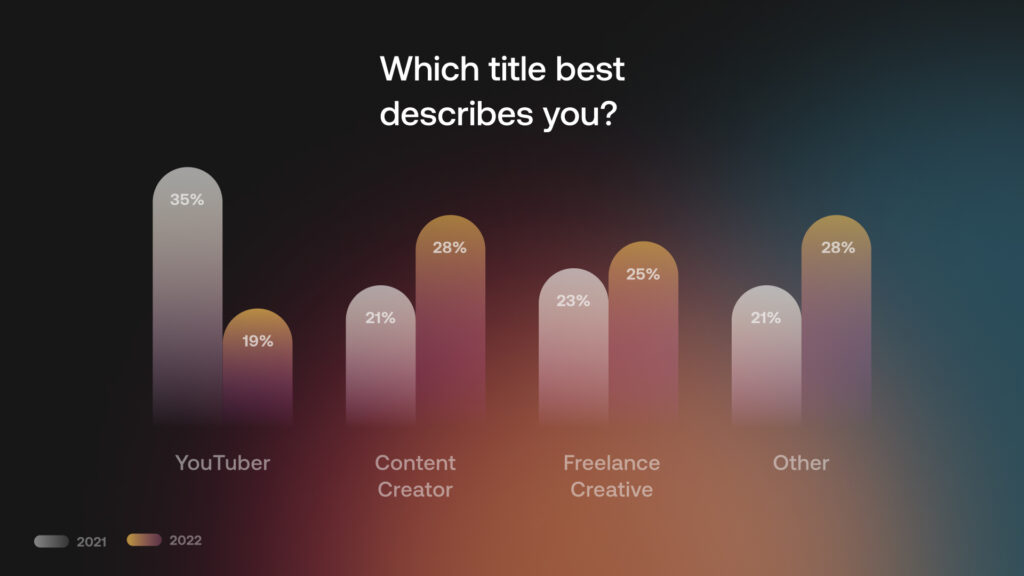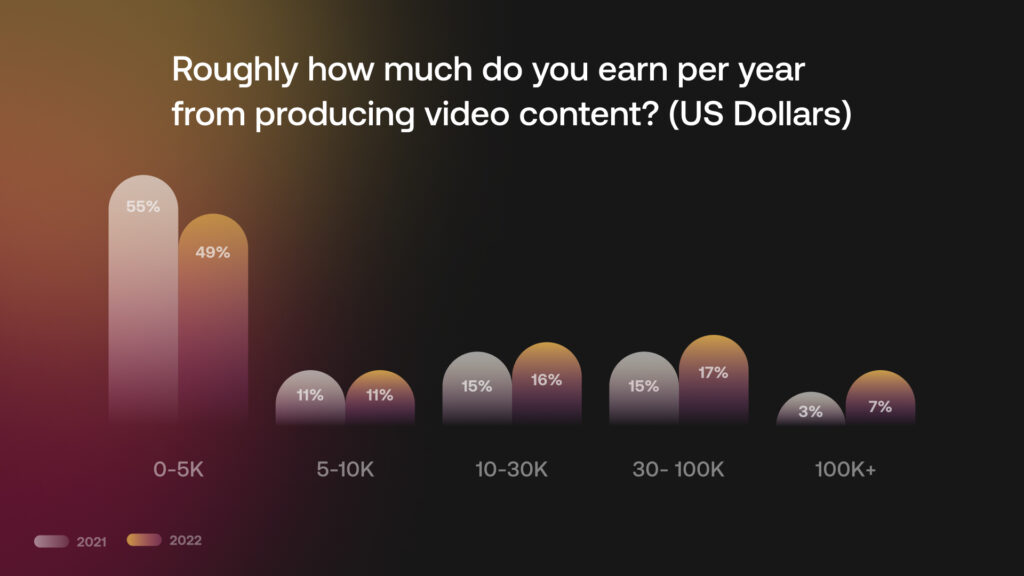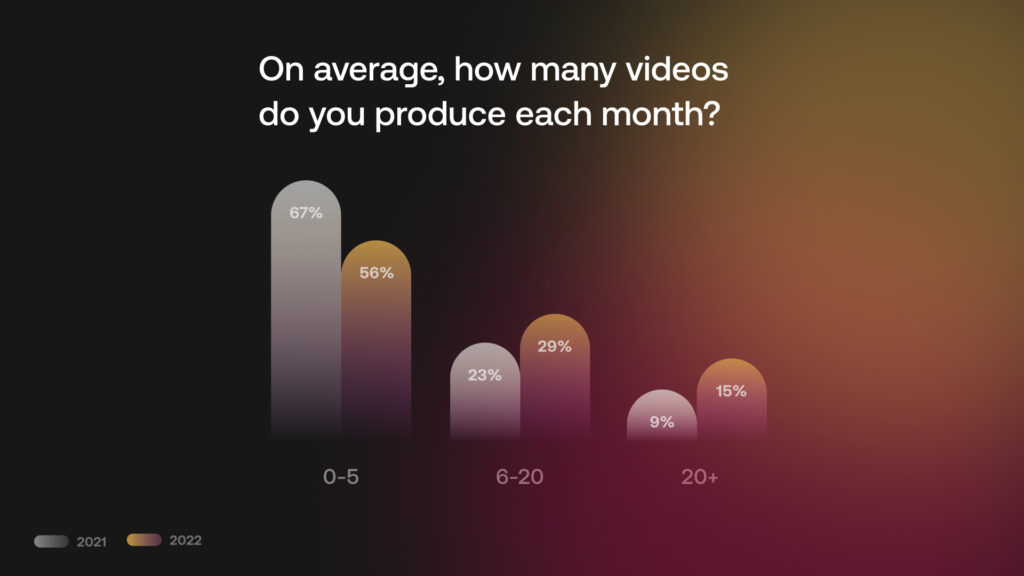Highlights
Table of Contents
Explore article topics
Every year we conduct our creator survey to check in with our community and see how the world of content creation is changing. Discover some of the trends from our 2023 creator survey and see how filmmakers and video creators have changed over the past 12 months.
From YouTubers to content creators
In last year’s survey, 35% of users – the largest group – defined themselves as YouTubers. This year there was a huge change with only 19% using this title, a drop of 16 percentage points.
Instead, the largest group now calls themselves Content Creators, with 28% of respondents using this term.
What lies behind this dramatic change? YouTube is still the most popular channel for people to distribute their videos with 67% of respondents using it vs 46% choosing Instagram and 18% uploading to TikTok.
Although the numbers for Instagram and TikTok remain significantly smaller than for YouTube, there’s a big change compared to last year, when 37% uploaded to Instagram and 10% to TikTok. In both cases, there’s a jump of almost 10 percentage points over the past 12 months (which for TikTok, means that the numbers have doubled).
So, people who used to self-define as YouTubers are still using YouTube to distribute their content – but now they are also uploading versions of it to Instagram and TikTok. They no longer define themselves as YouTubers exclusively. Instead, they are building followings across platforms and adapting their content accordingly.

The rise of the UGC economy
More than 60% of respondents answered that they upload their content online themselves, with 37% defining their content as “short films” and 34% as “commercial” (up 8 percentage points vs last year). If in the past, “short films” referred to narrative, cinematic films submitted to festivals, today the term includes a much wider range of video clips.
These numbers are connected to the fact that many content creators are discovering and monetizing UGC (user-generated content) which is seen as an increasingly important way for brands to communicate their messages authentically.
It also allows creators with relatively small followings to still be able to tap into the influencer marketing economy, which is valued at over $16 billion.
Get unlimited high-quality music for your videos
What is UGC?
UGC stands for User Generated Content, which is any form of content, such as images, videos, text, testimonials, and audio, that has been created and shared by users on online platforms like social media and discussion forums.
UGC is relatively new but is fast becoming an increasingly important revenue stream for many content creators.
People create commercial content by themselves and then companies use it as advertising. UGC creators don’t necessarily need many followers to make this content – they can produce ads for companies, and get paid per ad.
Liran Friedman, Head of Brand Marketing at Artlist, described how he uses UGC marketing.
“As a brand, I approach the creator who matches my brand values, even if they have a relatively small following, and ask them to talk about my product. Once the content’s ready, I run it as an ad.”
“Gen-Z grew up consuming content. They’re far savvier in methods for generating income while still staying authentic. Companies have realized that to reach Gen-Z and beyond, polished ads are less successful on platforms like YouTube, Facebook, and Instagram,” he continues. “Today’s consumers are looking for radical authenticity, to the point where it’s hard to tell whether they’re watching an ad.”
Digital content as a revenue stream
Over 60% of respondents indicated that they make a living from their content – an increase of 10 percentage points from 2021. A similar percentage see content creation as a professional pursuit, whereas only 40% would classify it as a hobby.
While annual earnings remain relatively low for most of the creators with about 50% earning only up to $5,000 per year, about 17% earn between $30-100,000 per year, and 7% making over $100,000 per year (a huge jump compared to 3% in 2021).
What’s caused the number of creators earning over $100,000 to double in the past year? One theory is that they have more channels than ever to share their content and more ways to make money. They can break out on Tiktok, YouTube Shorts, Twitch, and Instagram and then leverage their popularity to build personal brands and create revenue streams from sponsorships, partnerships, and product lines.

Friedman continues: “For the first time in many years, it’s possible to create content on three platforms and publish it simultaneously – without making adjustments to each platform. The most successful creators now have a multi-channel strategy.”
“One of the more prominent online creators is Mr. Beast. Thanks to his popularity, he recently managed to raise funding for cataract surgeries for 1,000 people suffering from partial or total blindness.”
According to Friedman, he may be the first YouTuber to become a billionaire this year.
“Another popular TikToker is Charli D’Amelio, who broke out on TikTok with dancing videos. Today, she and her family have an empire of products that revolve around her brand – podcasts, books, a reality series, and a makeup line.”
Content creation is now a career
People are making more videos over a longer period – indicating a shift in attitude towards content creation as a career path.
In 2021, over 40% of users responded that they’ve been creating videos for 1-2 years, whereas this year, that number dropped to only 24%. Meanwhile, nearly 20% indicated between 10-20 years of experience in the industry, over double 2021’s 9%.
There’s also been a significant jump in the amount of videos creators are making. In 2021 the majority of respondents, close to 70%, said they produce up to 5 videos per month. This year about 60% produce between 2-10 videos per month, 20% produce 11-40, and around 7% upload over 40 (nearly double the 2021 figure).
For many creators, making videos is no longer a hobby – it’s an active and profitable side hustle with the potential to become a full-time career.

The right assets can make all the difference
Once creators get their footage into the edit, finding the right soundtrack is key. When asked about the most significant element in the content creation process, about 93% mentioned background music, with 35% referencing sound effects.
As the creator economy grows, more and more content creators are coming to Artlist to soundtrack their videos with high-quality music produced by top international artists. Many of them reference the speed at which they’re able to find the perfect song thanks to the easy-to-use filters — and the fact that new music is added daily to help them keep up with trends.
Professionally-recorded sound effects are increasingly popular to add emphasis or character to videos; the newly added footage and video template libraries are also helping creators fill in gaps in their footage and add exciting visual effects.
Ultimately, helping creators find and use the right assets fast, simply dragging and dropping them into their editing timelines, is helping fuel Artlist’s growth in tandem with the creator economy.
This is still just the beginning
This is still just the tip of the iceberg for the creator economy. More and more tools are becoming available all the time to make it easier for people to create their content and get it in front of an audience.
Artlist fully expects these trends to continue into 2023 and beyond, as we see more and more people make a living out of content creation. We look forward to sharing insights from our next creators survey in due course.
When asked about the most significant element in the content creation process, about 93% mentioned the music (background music), 35% mentioned sound effects, and about 13% mentioned video clips.
“Influencer marketing, which is valued at over $16 billion annually, is central to the global economy,” says Friedman. “This allows us to provide a complementary end-to-end solution.”
“Recently, we’ve been seeing how artificial intelligence software within the creative industry enables us to produce content faster and better than ever, however, it won’t replace real content creators with a human touch. Content will be created with it, and those who don’t embrace this change will be left behind. At Artlist, we’ve already introduced artificial intelligence both in our catalogs and in editing.
Artlist, a creative technology company, surveyed approximately 5,000 users, resulting in interesting data about the current state of content creation. The users taking part in the survey were from a variety of backgrounds and from all around the world, mostly falling within the 16-34 age bracket. The findings point to a clear trend: the creation of online content continues to escalate.
Get unlimited high-quality music for your videos
Share this article
Did you find this article useful?
Related Posts
- By Artlist
- 5 MIN READ
- By Artlist
- 8 MIN READ
- By Jonathan Mateer
- 12 MIN READ
Latest Posts
- 25 Apr
- By Josh Edwards
- 4 MIN READ
